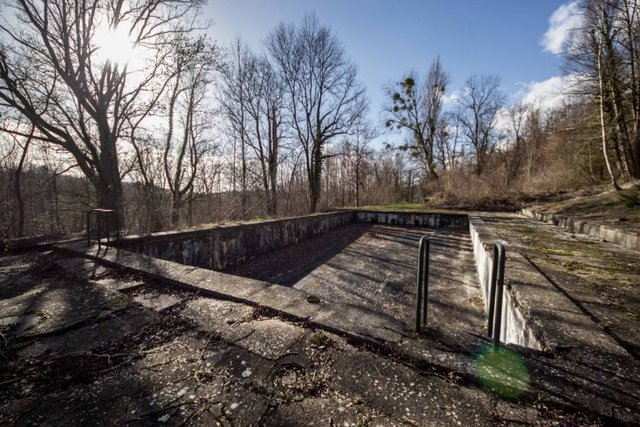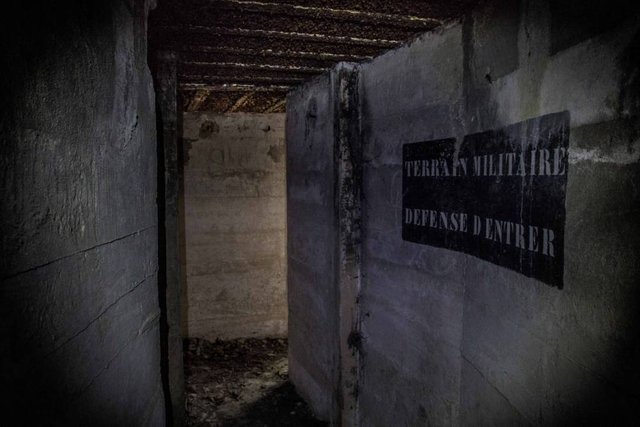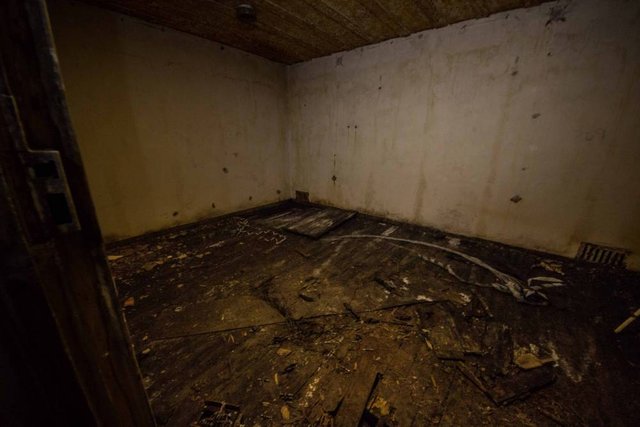This Guy Found Hitler’s Secret French Bunker
Adolf Hitler committed some of the most horrifying atrocities in human history, but when this photographer stumbled upon his secret French bunker, he was brave enough to go inside anyway.
The Explorer Who Found Hitler’s Bunker

Urban explorer and photographer Marc Askat braved the hunting season to walk through the thick wooded countryside in northern France. He was searching for a new subject for photographs and stumbled upon what is believed to be one of Adolf Hitler’s last bunkers— a place where the Nazi leader plotted the invasion of Britain.
The eerie underground stronghold is filled with stories from one of the most devastating wars in human history, but despite finding and photographing the bunker, Askat won’t reveal its exact location. It turns out he has a very good reason for keeping Hitler’s underground bunker location a secret from the public.
The History Buff

This isn’t the first time Parisian photographer Marc Askat has uncovered an intriguing World War II history site and photographed it. He’s also used soldier’s journals to uncover an underground World War II hospital and numerous wartime relics.
However, his latest adventure to uncover Hitler’s last bunker was more difficult. From the looks of this photo, this bunker was located off the radar pretty well deep in the forest. Most people know that Hitler fled to a bunker in German territory in a failed attempt to salvage his ailing war efforts, but that wasn’t the only bunker Hitler used. Askat uncovered a different bunker in France that was used to plan the invasion of Britain. You won’t believe what’s inside.
Crumbling Structure

After making his way through the dense forest during a dangerous time—hunting season—Askat saw a crumbling concrete building that was being enveloped by undergrowth and reclaimed by nature. He wasn’t entirely sure what he would find inside, but he pulled out his camera to document the experience.
Outside he found an enormous swimming pool. He researched and learned that a giant tarpaulin once hung above the pool to camouflage German officers as they swam. The empty pool was now covered in moss, but the grand scale of this Nazi bunker in the now peaceful French countryside seemed eerie.
A Way In

Now that Askat had located the bunker, he had to find a way in. The doors and windows were covered with rusty shutters—designed to keep intruders out. The entrance looks like something out of an Indian Jones film and for you to get in there is probably some complex way. Eventually, the urban explorer and photographer was able to find an opening.
The bunker Askat discovered was far from the only bunker Hitler had in France. The ruins of Nazi bunkers still exist throughout northern France, including the battle-ready bunker Batterie Todt near Normandy, and a rocket launching bunker that was never completed called Le Blockhaus. The Nazis occupied France for several years in World War II, ending with the Liberation of Paris in 1944.
Inside The Bunker

Askat entered the bunker and began exploring a massive network of tunnels and rooms that sprawled beneath the surface of the earth for six miles. At its deepest point, the underground bunker is close to 100 feet below the ground. Long hallways with different rooms on both sides spell for a ton of exploring. The windows were probably covered with something and we’re bare like in the photo above.
Inside he discovered crumbling ceilings, dark echoing hallways, and moss covered military phrases stamped on the chipped walls. The bunker is scary on its own, but knowing that it was once inhabited by the evilest man in the world makes the journey through the darkness even more chilling. During the occupation of France, Nazi’s brought terror and genocide to the country.
Historical Importance

Beyond the bunker’s staggering size, the underground stronghold Askat photographed has a significant historical importance. It was believed to be Hitler’s final headquarters outside of Germany. From this photograph, it is hard to distinguish what exactly is pictured but it resembles a labyrinth. At the time the bunker was built, Hitler planned to invade Britain—which didn’t work out.
He later planned to burn the city of Paris to the ground if the Allies captured the city; they did, but Hitler was holed up in his German bunker, support for the Nazis was waning, and he was unable to execute a military strategy at that point. The bunker Askat photographed may have been the site of major military decisions that resulted in massive death and destruction.
Who Lived There?

The name of the bunker Marc Askat found wasFührerhauptquartier Wolfsschlucht II, and Adolf Hitler wasn’t the only terrifying figure who resided there. Here you see the floorboards fell away and rusted pipes beneath. This wasn’t in every location of the bunker. The bunker served as the Nazis’ Western Front military command center and housed dozens of German officers and their staff.
The maze of passageways and rooms would’ve been full of Nazis plotting the expansion of their fascist regime. What makes this bunker all the more terrifying is that it was just one of ten similar sites used by Hitler during the war—which gives you an idea of just how vast their influence was. In a bunker like this one, it was difficult for Allied forces to find and attack Hitler.
A Bloody War

In this room you can see the ceiling is ripping off and more rust stains located on the wall underneath what appears to be a shelf. What that shelf held, we are unsure but it probably helped contribute to the gore of WWII. World War II was one of the bloodiest wars in history. The unprovoked German attack on Poland in 1939 set the war in motion, and it raged for six years until the Nazis were defeated in 1945. It was a brutal six years, with more than 50 million soldiers and civilians killed in the war.
A large portion of the death toll was due to the genocide of six million European Jews killed by Hitler’s directives. Death camps and concentration camps contributed one of the deadliest genocides in history. This genocide was carried out in stages, with the extermination camps eventually posed as “the Final Solution to the Jewish Question.” The bunker is a reminder of this horrifying chapter in history.
The Spread Of Antisemitism

This room looks particularly interesting. There are tanks along the wall and something that resembles a long horizontal medicine cabinet. What on earth was kept in here? More rust and mold on the ceiling can be seen as well. Antisemitism was not a new concept when Hitler rose to power—and he preyed on this fear of the other by scapegoating Jews for the economic problems and social unrest Germany was facing after World War I. The historian and scholar Eberhard Jackel wrote about why the Holocaust was so shocking to those who lived through it.
“Never before had a state with the authority of its responsible leader decided and announced that a specific human group, including its aged, its women, and its children and infants, would be killed as quickly as possible, and then carried through this resolution using every possible means of state power.”
A Slow Build

Though many of us are unable to visit harrowing historical sites like this one, the photos remind us that state sanctioned violence on a scale as massive as the Holocaust didn’t happen overnight. It took resources, supporters, and infrastructure. Terrain militaire defense d’entrer as you see on the wall directly translates to military ground defense of entering. The armed forces would be here it appears.
When the Third Reich was first established, they started ordering Jewish Germans by dividing the population into two categories: “national comrades” and “community aliens.” Nazis also further divided people by their perceived offenses: “racial” enemies (e.g. Jews and Romani), political enemies (e.g. Marxists and liberals), and moral enemies (e.g. gays and lesbians). The first step was propaganda that instilled fear about these groups and turned neighbors against them.
Harrowing History

Inside the dark and dingy bunker, Askat found harrowing reminders of the past. Though many of the floorboards had fallen away to reveal rusty pipes underneath, there were still old canisters and decaying debris strewn around some rooms—a reminder that this space was lived in.
Before underground bunkers, the legal and social rights of Jews were slowly but steadily being restricted in Germany. Throughout the 1930s, several anti-Semitic laws were passed. In 1933, Jews and other “non-Aryans” were barred from civil service. Jews were also barred from owning farms. Jewish lawyers were abruptly disbarred, and judges were dragged from their courtrooms and beaten.
If Walls Could Talk

Inside the bunker, Askat photographed the winding concrete corridors deep underground. These gloomy passageways were reinforced with thick cement walls and metal doors to protect the Nazis plotting underground from Allied forces. This bunker was one that you had to get used to or else you would probably get lost byt the looks of this photo.
To get to this point, the Nazis stripped Jews of more and more rights until they had few ways to resist.
In 1933, a major eugenics law was also passed, and 400,000 people were sterilized against their will. The Nuremberg Laws, passed in 1935 by Hitler, also prohibited “Aryan” Germans from having relationships with Jews and later other “non-Aryan” groups. Many persecuted artists and intellectuals fled Germany before World War II.
The Secret Location

After finding and photographing the bunker, Askat was pleased and wanted to show off his historical find to the world. This is a good shot of the outside of bunker which might lead some to think this was it but they had no clue about the whole underground. He uploaded photographs of the complex to Facebook, but people quickly noticed a bit of important information was missing: the location of the underground bunker.
It turns out Askat had a very good reason for keeping the location a secret. He wasn’t just trying to keep the location and all the great photos to himself. He was protecting something very important about the complex. It was still in use, and the reason for its use had changed a lot since its original purpose as Hitler’s bunker.
The Bunker Today

The bunker Marc Askat stumbled upon may have once served as an underground stronghold for Nazi forces and Hitler, but today it serves a much different purpose. From the looks of these doors, it would have taken a ton of man force to infiltrate through this bunker if all doors were shut and locked. The top-secret location is actually currently a training site for the French Foreign Legion.
Askat knew the importance of keeping the precise location a secret, even though he wanted to share his discovery with the world. Though the location of Hitler’s French hideout is concealed from the rest of the world, Askat’s photos give us a glimpse into the past without compromising the location. The photos remind us of important history and serve as a warning to current and future generations.
The East Berlin Bunker

The secret bunker in France may have been eerie but Hitler’s not so discreet bunker in East Berlin almost packed the same punch as far as being creepy goes. a man by the name of Robert Conrad took some risks when he disguised himself as a construction worker to take photos of this bunker. This photo here appears to be the opening of one of the entrances to the bunker. Taken from an obscure angle, you can still see the intricacies to this bunker. He would sneak in 30 times before finally releasing the photos.
There were guards, dark tunnels, and explosions but he trekked on so he could be able to show the world these horrific truths. “I walked very slowly across the site, as if on eggshells, so no one would notice me,” he recalls.